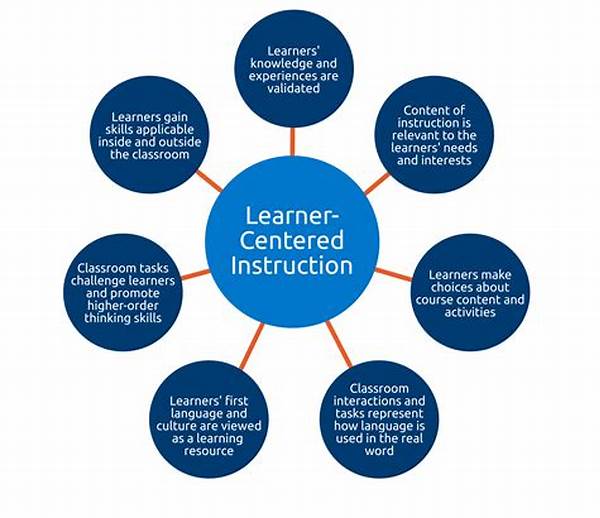In today’s rapidly evolving educational landscape, the traditional methodologies of teaching have come under scrutiny. A shift towards more student-focused paradigms has emerged prominently, notably within the field of mathematics. The learner-centered math instruction approach has garnered attention for its ability to foster deeper understanding and engagement among students. Within this framework, the learner becomes an active participant in their own educational journey, rather than a passive recipient of information. By emphasizing student agency, this method aims to cultivate critical thinking and problem-solving skills, enabling learners to apply mathematical concepts in real-world contexts.
Read Now : Credible Digital Learning Diplomas
Key Principles of Learner-Centered Math Instruction
The learner-centered math instruction approach is grounded in several core principles aimed at enhancing student involvement and understanding. First, it emphasizes the importance of personalizing instruction to cater to the diverse needs and learning styles of each student. This may involve adapting lesson plans, employing a variety of teaching aids, and utilizing technology to create a more inclusive learning environment. Second, it fosters an interactive classroom environment where students are encouraged to explore concepts through discussions, collaborative work, and hands-on activities. This collaborative participation facilitates the exchange of ideas and promotes a deeper comprehension of mathematical concepts. Third, continuous feedback and assessment play a crucial role in the learner-centered approach. Through regular evaluations and constructive feedback, students receive insights into their progress and areas that require improvement. This continuous cycle of feedback enhances learning and builds student confidence. Lastly, the learner-centered math instruction approach supports self-directed learning by empowering students to take ownership of their educational journey. By developing learning strategies and setting achievable goals, students become active contributors to their academic success.
Implementing Learner-Centered Math Instruction: Practical Aspects
1. Personalized Learning Plans: This aspect involves tailoring educational content and strategies to meet the individual needs of students, taking into account their strengths, weaknesses, and interests.
2. Collaborative Learning Environments: Encouraging group work and peer-to-peer interactions allows students to learn from one another and develop communication skills alongside mathematical proficiency.
3. Use of Technology: Incorporating digital tools and resources aids in making mathematics more engaging and accessible, providing varied ways for students to interact with content.
4. Formative Assessment: Ongoing assessments are crucial in adapting teaching methods and materials to address the evolving needs of each student effectively.
5. Encouragement of Autonomous Learning: Fostering independence through self-paced learning modules and reflection activities helps students gain confidence and master mathematical concepts at their own speed.
Challenges and Opportunities in Adopting Learner-Centered Math Instruction
The transition to a learner-centered math instruction approach is not without its challenges. Teachers may require additional training to effectively design and implement personalized lesson plans. Additionally, creating a classroom environment conducive to collaborative learning may necessitate alterations to existing school infrastructure or scheduling. However, the opportunities afforded by this approach are significant. Students exposed to learner-centered math instruction often demonstrate improved academic performance and engagement. By embracing technology and innovative teaching methods, educators can inspire a greater interest in mathematics and develop critical life skills among students that extend beyond the classroom.
Read Now : Green Innovation In Strategic Partnerships
Critical Examination of Learner-Centered Math Instruction
To fully realize the potential of the learner-centered math instruction approach, a comprehensive understanding of its theoretical underpinnings and practical applications is essential. This begins with acknowledging the evolution of educational philosophies which have gradually progressed from teacher-centric models to student-focused paradigms. Constructivist theories, which emphasize learning as an active, contextualized process, serve as the backbone of learner-centered education. In the realm of mathematics, this involves prioritizing the relevance of mathematical concepts to real-world contexts, enabling students to make meaningful connections between theory and practice.
The promotion of a learner-centered math instruction approach necessitates supportive policies, professional development for educators, and a collaborative effort among stakeholders including administrators, teachers, parents, and students. The effectiveness of this approach relies heavily on the adaptability of educators and the availability of resources to support innovative teaching methods. By providing teachers with the necessary tools and training, and fostering open communication among all stakeholders, the foundation for a successful transition to learner-centered instruction can be established.
Long-Term Impacts of Learner-Centered Math Instruction
The learner-centered math instruction approach has the potential to reshape educational outcomes by fostering a more inclusive and effective learning environment. In the long term, students who have been exposed to this method are likely to develop strong analytical and problem-solving skills. These attributes are invaluable in today’s complex, interconnected world where mathematical literacy is more important than ever. Furthermore, as students become more engaged in their learning process, they are more likely to pursue advanced studies in mathematics and related fields, contributing to a skilled workforce prepared to address future challenges.
Summary of Learner-Centered Math Instruction Approach
In conclusion, the learner-centered math instruction approach represents a shift towards a more personalized, engaging, and effective paradigm in mathematics education. By placing the student at the center of the learning experience, this approach encourages deeper understanding, critical thinking, and the practical application of mathematical concepts. Although the transition to this model presents challenges, the potential benefits are compelling. Educators are empowered to facilitate more meaningful and dynamic learning experiences, while students gain the skills and confidence necessary to excel in both academic and real-world contexts. As educational systems worldwide strive to prepare students for an uncertain future, the adoption of learner-centered methods may prove integral in equipping learners with the necessary tools for success. Through the collective efforts of educational stakeholders, the promise of the learner-centered math instruction approach can be realized, leading to a brighter future for students around the globe.
